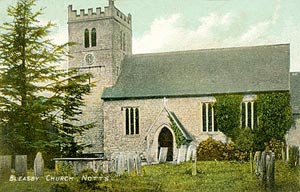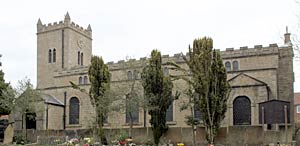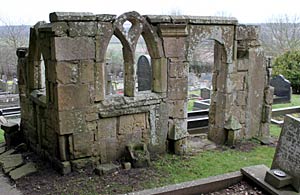The Way Paulinus Came
BLEASBY. Quiet and charming is this small village, with its church, an inn with white walls and red roof, and a hall about 400 years old, its embattled turrets peeping out from the trees.
Clustered on the hillside is the hamlet of Goverton, and on the other side a narrow lane winds to where the ferry crosses the Trent (flowing here at its swiftest) to a fine stretch of wooded bank. Bleasby claims that Paulinus baptised his converts in the river here as he went through Notts in the 7th century.

Bleasby church, c.1905.
As high as the sturdy embattled tower is a fine old cedar in the churchyard, which has a peace memorial at its gate. The church has lost most of its original work, and has nothing older than the 13th century arcade, with round pillars and capitals. There is an Elizabethan chalice. Bright inside when the sun shines, and filled with mellow light from tinted glass when the day is dull, it has lovely glass in a south window glowing red and blue and purple, with a charming group of the Madonna and Child and a minstrel angel at each side. It is one of the fine windows from the workshops of Christopher Whall whose glass we so often come upon with pleasure in our churches.
The Remarkable Story of a Church Window
BLIDWORTH. In the heart of Sherwood Forest, sharing with it the spirit of the gentlest robber that ever was, stands this home of legend and romance, looking out from its hill to the distant landmarks of Newark's spire, the towers of Lincoln, and the walls of Belvoir Castle.
How old Blidworth is no one knows. Some great natural boulders at the foot of the hill have been called Druid remains, and one (nearly 90 feet round and 15 feet high) has a passage through the middle. The Romans may have had an encampment here. At Blidworth Dale King John had a hunting seat, and not far away is the Queen's Dower where Elizabeth is said to have camped during one of her progresses. Rainworth Lodge, a mile and a half away, has some remains of Tudor days.

Blidworth church in 2010.
The church crowns the hilltop. Except for its plain 15th century tower, it is mainly in the classical style of the 18th and 19th centuries, but the lofty south arcade of round arches and pillars is said to have been the work of a pupil of Christopher Wren. The 15th century font has a bowl on which is carved the head of a child, and its modern oak cover was made by the village carpenter.
On the wall above the font hangs what is called the Register of Rockings, a reminder of an old custom revived here in our time after a lapse of a century. Once a year, on the first Sunday in February, the last baby boy to have been baptised is dedicated at the altar and rocked in a cradle in the sanctuary. In olden days the Rocking was observed as a simple miracle play, representing the taking of Jesus to the Temple.

Fragments of the medieval church in 2010.
Built up in the churchyard are fragments of the medieval church which collapsed two centuries ago, including many old coffin stones, a doorway, a window, and a piscina niche. In the outside wall of the church is a tiny tapering coffin stone, and a 15th century floorstone in the nave has a hammer and a carpenter's square.
The oak panelling in the chancel, with a few richly carved panels, came from Southwell Minster. So, too, did the unusual oak pulpit adorned with 18th century plasterwork showing 31 tiny heads and a panel of the Madonna and Child. One very odd possession the church has, for the spring which carries the pendulum of the clock in the tower is made from a sword carried at Waterloo.
A slate tablet on the wall has a rhyming epitaph telling how Thomas Leake fell in single combat near the end of the 16th century. He was a Ranger of the Forest, and carved in the alabaster frame of his memorial are hunting trophies of horns, knives, long-bows and cross bows, and hounds, one hound chasing a deer. The massive stone cross in the churchyard was brought here from the spot in the woods where he fell.
Among many memorials of the Needs, a soldier family who lived at Fountain Dale, is a window filled with Munich glass which is both pleasing and interesting, recalling an odd tale of war. It shows St Anne teaching Mary to read, the mother wearing a red mantle over her white robe and an amethyst wrap over her head, Mary kneeling on a rich blue cushion. The glass was ordered from a firm at Metz before the Franco-German war, and was fashioned by the French during the Siege of Metz. After the war enquiries were made about it, and in due course it arrived at Blidworth. A few months later a second window, identical with the first, was received, the explanation being that the Germans carried on the industry when in possession of Metz, and took the letter of enquiry to be another order. The second window was returned, and found a place in Cologne Cathedral.
The old men here will tell you that Robin Hood's Will Scarlet lies in the churchyard, and whether it is true or not we think he would have been glad to have this resting-place so near the scenes of his great adventures. One of that band of outlaws about whom so much has been imagined and so little is known, he was a merry spirit who knew every path through the forest. In the hill on which the village stands is a cave where the outlaws are said to have stored their food, and the records of Edwinstone church tell how Robin Hood took Maid Marian to be married there from her home at Blidworth.
Nowhere do their memories cling more surely than at Fountain Dale (a mile or so from the village), the source of the delightful little Rainworth Water, in a lovely setting by Harlow Wood. Here Friar Tuck is said to have lived, and it is supposed to be the scene of his fight with Robin Hood, which ended in a friendship broken only by death. Till half a century ago the Friar's cell could be seen. His well and the moat into which Robin was tumbled after the fight are still in the woods; and in the old house of Fountain Dale (modernised now) Scott often stayed, gleaning local colour for his immortal novels.
The story of Blidworth will live in spite of the fact that a colliery has come to mar the rural scene, and the old village will long be loved as the setting of Forest Folk, a tale of Nottinghamshire life written in our own time by a Nottingham man, James Prior Kirk.
